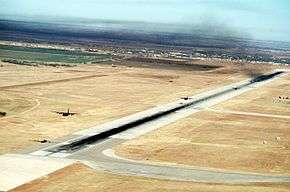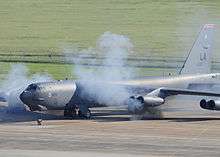Minimum interval takeoff
A minimum interval takeoff (MITO) is a technique of the United States Air Force for scrambling all available bomber and tanker aircraft at twelve- and fifteen-second intervals, respectively.[1] Before takeoff, the aircraft perform an elephant walk to the runway. It is designed to maximize the number of aircraft launched in the least amount of time possible before the base suffers a nuclear strike, which would obliterate all remaining aircraft.
Although the practice is aimed to efficiently send aircraft off as quickly as possible, it does not come without risks. Sending aircraft into the slipstream of another aircraft at such close intervals could cause the plane to jump up and down, possibly causing it to flip over. More than once, aircraft have crashed on takeoff after encountering such turbulence.
Description
The minimum interval takeoff was designed by the United States Air Force to get its bomber fleet in the air within fifteen minutes of an alert of an incoming missile attack, that being the time in which the bases would be obliterated.[1] Although it had roots during World War II, the tactic came of age during the Cold War.
Tactical use

Strategic Air Command bomber and tanker crews would frequently practice these drills, as they knew they had to send up the maximum number of planes, in the fastest time possible. This was done to prevent possible obliteration should the base be attacked by nuclear warheads. In theory, the whole procedure had to be done as soon as possible, as there would be minutes to spare in the event of an attack warning. This meant that the aircraft would be launched as quickly as 12 seconds between bombers, and 15 seconds between the tankers. Normally, aircraft are delayed from taking off until the turbulence created by the aircraft ahead of it has dissipated. Because of the small launch window, this made the air very rough for the next minute for the aircraft, during the takeoff roll and initial climbout. Water injection in the J57 produced extra power for takeoff but caused large amounts of unburned fuel to leave the engine in the exhaust, producing large amounts of black smoke which the subsequent aircraft would also have to go through in order to take off successfully. The J57 was fitted to all B-52s with the exception of the H-model.[2] During alerts, the men would perform an elephant walk from the Christmas tree, and then launch as quickly as possible. Typically, takeoff clearance would be received by the aircraft once the aircraft ahead of it was on the runway.
Upon taking off, the navigator would call milestones, indicating the minimum speed at important positions on the runway. If the aircraft wasn't at speed during S1 time (120 knots, 140 mph), the plane would have to abort takeoff. If S1 was successfully achieved, the wings start generating lift, becoming exposed to the violent turbulence that it immediately encountered. The nose is still held kept down at this point. At 152 knots, another milestone, pilot pulls the yoke back, and the plane would lift off.[3]
At Pease Air Force Base, New Hampshire it has been reported that Boeing B-47 Stratojet aircraft would launch at opposing sides of the single runway at 7.5 second intervals, half that of a normal MITO. Later Pease Air Force Base and Plattsburgh Air Force Base, New York would be equipped with FB-111 strategic bombers and the MITO interval was reduced to just 6 seconds between aircraft if they used alternating opposite sides of the same runway. Pease and Plattsburgh assigned KC-135 aircraft would use a 12 second MITO interval using the runway centerline.[4]
Incidents

One B-52 was involved in a crash during a MITO when the aircraft stalled.[5]
On the morning of December 16, 1982, A B-52G Stratofortress of the 328th Bombardment Squadron, 93rd Bombardment Wing, at Castle Air Force Base crashed while attempting a MITO, killing all nine crewmembers on board. It had just taken off from Mather Air Force Base when they encountered trouble. The aircraft, which was carrying 290,000 pounds of fuel, crashed about a mile and a half from Mather and blew up in a ball of fire around 250 feet in diameter. The resulting crash left a 400-yard path of burning debris, killed three horses, and left four people needing treatment for smoke inhalation.[6] The cause was determined to have been the result of the jet trying to avoid the jet blast of the lead plane, showing the inherent risk behind launching aircraft so close together.
A "Broken Arrow" incident originated from a minimum interval takeoff incident on December 8, 1964. During a normal MITO at Bunker Hill Air Force Base, Indiana, a Convair B-58 Hustler, loaded with six nuclear weapons, suffered a landing gear failure. This caused the pilot to lose control, which also caused a rupture of the fuel cell holding JP-4 fuel, causing an immediate fire under the aircraft. The pilot and defensive systems operator survived the fire and abandoned the aircraft; the navigator ejected, but was killed. The resulting fire consumed the aircraft and some nuclear weapons, causing contamination in the immediate vicinity.[7]
On 4 January 1961, during a minimum interval takeoff from Pease AFB, New Hampshire, a Boeing B-47E Stratojet, 53-4244, of the 100th Bomb Wing, number 2 in a three-ship cell, lost control, crashed into trees, and burned. The aircraft commander, Capt. Thomas C. Weller, co-pilot 1st Lt. Ronald Chapo, navigator 1st Lt. J. A. Wether, and crew chief S/Sgt. Stephen J. Merva were killed.[8]
Pop culture
There is a scene from the film A Gathering of Eagles during which a MITO is observed to occur from beside the runway at Beale Air Force Base. The scene involves Colonels James Caldwell (played by Rock Hudson) and Hollis Farr (played by Rod Taylor) standing a few thousand feet down the runway, watching B-52 Stratofortresses take off at fifteen-second intervals.
See also
References
- Yenne, Bill (15 December 2012). B-52 Stratofortress The Story of the Buff from Drawing Board to the Skies over Afghanistan. Zenith Pr. p. 57. ISBN 0760343020.
- "MITO Takeoffs, Loring AFB, Maine 1984". All-hazards.com. Retrieved 9 August 2012.
- Jones, Tom (2006). Sky Walking : An Astronaut's Memoir (1st Smithsonian Books ed.). New York: Smithsonian Books/Collins. ISBN 978-0060851521.
- When the Wolf Rises Linebacker II, the Eleven Day War. Authorhouse. p. 280. ISBN 978-1468525373.
- Ficarrotta, ed. by J. Carl (2001). The Leader's Imperative : Ethics, Integrity, and Responsibility. West Lafayette, Ind.: Purdue Univ. Press. ISBN 978-1557531841.CS1 maint: extra text: authors list (link)
- Beitler, Stuart. "Mather Air Force Base, CA B-52G Bomber Crash, Dec 1982". Archived from the original on 27 July 2014. Retrieved 9 August 2012.
- Brewer, Randy (2012). "Broken Arrow Incident involving B-58A-CF 60-1116". B-58.com. Archived from the original on 28 November 2012. Retrieved 9 August 2012.
- Lloyd, Alwyn T., "Boeing's B-47 Stratojet", Specialty Press, North Branch, Minnesota, 2005, ISBN 978-1-58007-071-3, page 160.
External links
| Wikimedia Commons has media related to Minimum Interval Takeoff. |